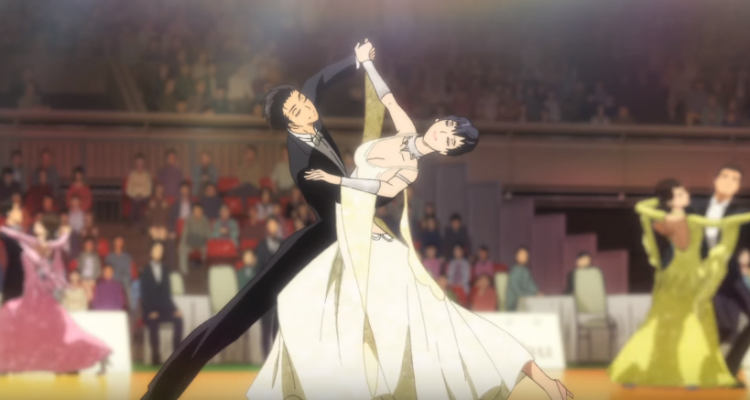Welcome to the Ballroom
June 10, 2019 · 0 comments
By Andrew Osmond.
 The Production I.G series Welcome to the Ballroom may be an anime about competitive dance, but it also has much in common with anime sports shows (I’ll stay out of the debate about if competitive dancing actually is a sport). In one scene in the series, an elementary school-aged little boy shows off playing baseball with his friends. Then he’s distracted by the appearance of his annoying kid sister, who pokes her head around a wall, asking him to come and do dancing with her.
The Production I.G series Welcome to the Ballroom may be an anime about competitive dance, but it also has much in common with anime sports shows (I’ll stay out of the debate about if competitive dancing actually is a sport). In one scene in the series, an elementary school-aged little boy shows off playing baseball with his friends. Then he’s distracted by the appearance of his annoying kid sister, who pokes her head around a wall, asking him to come and do dancing with her.
He shuns her – why on earth would he want to do something so girly? – but he later sees her peeping wistfully into a studio, where people practice steps with unearthly grace. Soon the boy has partnered with his sis after all, and despite his protests – dancing, he realises, is far more physically exhausting than any ball game – he keeps it up, entering the competition circuit, realising it’s what he wants more than anything else…
This isn’t how Ballroom begins, nor is the boy in these scenes the main character. All of the above is revealed in a ten-year flashback some way into the story, by which time the boy has been established as an adversary. He’s pushed away his sister, who’s now paired up with the actual main character – another boy – and is competing against him. All of this goes to illustrate how the storytelling in this anime melodrama works.
But Ballroom plays much like a sports show: the gruelling training, the epic contests, the hierarchies and rivalries. From another perspective you could compare Ballroom to Tokyo Ghoul. No, we don’t mean that it has flesh-eating monsters on the dancefloor, but rather that it’s about a naïve boy entering a strange new world and realising how long it’s been going on without him.
Most of the characters have been dancing for far longer than the actual protagonist. He’s Tatara, a middle-schooler, who stumbles upon dancing quite by accident. He spots a pretty girl from his school, and can’t help looking at the building she’s gone into; of course, it’s a dance studio. Some thugs surround Tatara as he hovers, but he’s saved by a towering male stranger called Kaname.
Naturally, Kaname assumes Tatara is interested in dancing, drags him into the studio, and (literally) beats him into adopting a straighter posture. Tatara looks into a mirror and sees a more upright version of himself than he’s ever seen before. He gets more inspiration from a video of Kaname’s own proud dancing – it turns out this guy is a real Emperor of the ballroom – and becomes a bright-eyed convert.
In the early episodes, you might assume this was very much a male-friendship show, with all the undertones that go with it. After all, Ballroom it came out not long after a certain other male dancing anime that revelled in homoeroticism – let’s just say “ice”. But Ballroom is far more of a mix, as important new characters are introduced along the way and different relationships come to the fore. There are certainly slender beautiful boys for the fangirls, but also (sadly retrograde) fan-service gags at the expense of the female characters.
Tatara is the main character, with his bright eyed, shonen manga-style enthusiasm, and the show certainly encourages you to root for this rookie. However, you may find yourself betting on other players instead. Ballroom is about the values foregrounded by the dancefloor, about ego versus partnership, about crowd-pleasing flash versus artistic substance, about strutting self-expression versus learning to get out of the way. One striking scene has two characters out on the dance floor, in front of a crowd. Then one of them “disappears” from the audience’s perception, while the other is glorified by the invisible dancer’s efforts.
Generally, Ballroom doesn’t show whole dances. Instead, we get snippets of movement, stylised frames of curving bodies, audience reactions, and characters’ inner monologues stretching time as only anime does. It’s a controversial approach, but it’s possible to get used to it. After all, this is visual storytelling in the spirit of manga, and indeed the series was based on a manga, by Tomo Takeuchi. True, we might have reasonably expected something more cinematic from Production I.G, but there’s never been just one way to dance.
Ballroom’s splendidly designed characters are by famed artist Takahiro Kishida, whose credits include Durarara!! Madoka Magica, and far older anime like Serial Experiments Lain. His Ballroom characters are built to strut and stretch, with elongated necks that are integral to the show’s designs. When I wrote up Ballroom in Neo magazine, I claimed of the characters’ necks that, “Once you notice them, they’re as impossible to un-see as Escaflowne’s noses.” Except that after a while, I realised I wasn’t noticing them anymore.
Andrew Osmond is the author of 100 Animated Feature Films. Welcome to the Ballroom is released in the UK by Anime Limited.
Leave a Reply